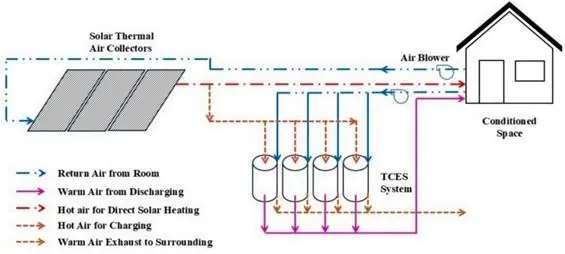
The researchers developed a prototype that first uses solar thermal air collectors, which harness sunlight to heat air in the summer.
Mumbai, Maharashtra: For nearly a quarter of the year, temperatures in the cold Himalayan north plunge well below freezing. To keep warm, families in places like snow-covered Leh rely on diesel heaters — carbon-heavy machines powered by costly fuel that must be trucked in over perilous winter roads. But what if the same intense summer sun that bathes these mountains could be captured and saved for later, ready to warm homes months after it has set? A team of researchers from the Indian Institute of Technology Bombay (IIT Bombay) believes this is possible.
In a recent study, the team proposes using thermochemical storage powered by a compound called strontium bromide to address the region’s seasonal heating needs. Strontium bromide has been the subject of many studies examining thermochemical storage. Much like a battery stores electricity, thermochemical storage stores heat in the form of chemical energy. The salt is chosen for its high energy density, chemical stability, non-toxicity, non-explosiveness, and environmental safety.
Also Read | ‘How Do Cells Decide Which Way To Grow?’ IIT Bombay Research On Tissue Organisation
The researchers developed a prototype that first uses solar thermal air collectors, which harness sunlight to heat air in the summer. This hot air is then used to warm hydrated strontium bromide (hexahydrate). In this form, the strontium bromide crystals contain water molecules within their structure. During the heating process, the material undergoes an endothermic dehydration reaction, expelling water molecules and storing the absorbed solar energy as chemical potential in the resulting monohydrate salt. In winter, moist air is passed through the “charged” salt, triggering a rehydration reaction that releases the stored heat.
This technology offers a sustainable solution in Himalayan regions that face long, frigid winters and limited access to clean heating options, where diesel and firewood are the primary, and polluting, choices. Thermochemical storage’s ability to retain energy for several months makes it particularly suited to such remote, high-altitude areas.
Dr. Rudrodip Majumdar, who worked on the project as a postdoctoral fellow at IIT Bombay and is now with the National Institute of Advanced Studies (NIAS), said the work was deeply personal. “I went to the Chopta-Tungnath-Chandrashila trek and stayed in camps. The starry nights in the Himalayas are beautiful, but the night stay can turn very hostile,” he said. “I’ve seen people struggling, walking ten kilometers just to collect firewood. Diesel becomes the only backup, but it’s a heavy polluter.”
To help such communities, the team designed a module capable of storing around 500 kilowatt-hours of energy — enough to heat a small Himalayan home for up to four months. The entire setup consists of a simple, modular unit: solar thermal collectors, a reactor chamber filled with strontium bromide salt, and a small air circulation system to drive the dehydration and rehydration cycles. The reactor is housed in a compact, weatherproof unit insulated with glass wool, designed to withstand harsh mountain conditions.

Schematic representation of the proposed seasonal solar heating system and the airflow (A.S. Pujari et al., Applied Thermal Engineering 269 (2025) 126090)
“Solar collectors are well-proven. Steel tanks have been made for ages. The only new contribution is stabilising the thermochemical material and packaging it for daily life,” added Dr. Majumdar. “This kind of long-term seasonal storage is made possible because the energy stored in the material is very stable. It does not degrade over time.”
The module itself, according to study lead Dr. Sandip Kumar Saha, is roughly the size of two LPG cylinders and designed to be portable. These units can be recharged in sunny regions like Gujarat or Rajasthan and trucked to the Himalayas before winter.
The team tested the material through six full charging and discharging cycles in the lab with no performance degradation. In theory, strontium bromide can handle 500 to 600 cycles, meaning each unit could function for several years.
While initial costs may be higher than diesel heaters, the study finds that thermochemical systems are more economical over time — especially in remote regions where diesel is expensive to transport and where environmental penalties could increase the overall cost.
“If we want to produce electricity from diesel today, it will cost us Rs 50 per unit (kWh),” said Dr. Majumdar. “If we add a carbon penalty, it could go up to Rs 78 per unit. Then the thermochemical solution will be half the price.”
The study calculated the Levelized Cost of Heating (LCOH) — the average cost of producing usable heat over the lifetime of the system, to be between Rs 33–Rs 51 per kWh in different Himalayan cities. In Leh, LCOH dropped to Rs 31/kWh, making it the most affordable among all regions studied, including Darjeeling, Shillong, Dehradun, Shimla, Jammu, Srinagar, and Manali.
Dr. Chandramouli Subramaniam, another author on the study, added that solar-thermal energy solutions for space-heating have already been tested for the Indian Army in sub-zero conditions, and that the team is working on smoke-free heating systems for army camps stationed at high altitudes.
Also Read | PCOS Likely To Compromise Attention-Based Tasks In Affected Women: IIT Bombay Study
Despite its promise, the technology faces challenges before it can be deployed at scale. Globally, thermochemical storage has only been piloted in countries like Germany, and India is yet to test the solution widely in homes. The system’s efficiency also depends on adequate summer sun and winter humidity, which varies across Himalayan regions.
Still, the researchers are optimistic. With policy support, community engagement, and field trials, they believe the technology can help build a more inclusive and sustainable energy future.
“Energy is very related to quality of life,” Dr. Majumdar said. “Energy poverty should not exist in the 21st century. We need to ensure that even the remotest parts of the country are energy secure.”













